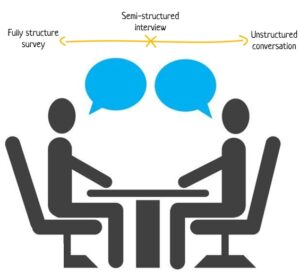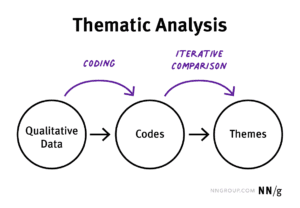Data analysis for semi-structured interview: A complete guide
-
Bella Williams
- 10 min read
The semi-structured interview is a cornerstone of qualitative research, a powerful tool for truly understanding people’s experiences and perspectives. Unlike rigid questionnaires, it allows for natural conversations while still ensuring key topics are covered. But once you’ve conducted these rich discussions, the real work begins: making sense of the mountains of data.
Incorporating techniques such as thematic coding and pattern recognition further enhances the analysis process. Researchers can sift through interviews to identify recurring themes and unique insights, ultimately transforming raw data into actionable knowledge.
Understanding how to analyze these interviews effectively is crucial for deriving value and making informed decisions based on participant feedback.
This guide is designed to be your ultimate resource for analyzing semi-structured interview data. From understanding the foundational concepts to mastering advanced techniques, we’ll walk you through every step of the process.
By the end of this guide, you’ll know:
- What semi-structured interviews are and why they’re valuable in research.
- How to analyze semi-structured interview data step-by-step.
- The tools and best practices that can elevate your analysis process.
Let’s examine the essentials of semi-structured interview data analysis and explore how to transform raw data into meaningful conclusions.
Understanding Semi-Structured Interview Analysis

Semi-Structured Interview Analysis offers a unique approach to data collection and interpretation. By blending structured and unstructured methods, it allows researchers to explore complex topics while still guiding conversations through predefined questions.
This flexibility enables interviewers to probe deeper into participant responses, uncovering insights that might remain hidden in a fully structured format.
To effectively analyze semi-structured interviews, it’s essential to follow a few key steps.
First, transcribe the interviews accurately, preserving the nuances of speech. Next, adopt a coding strategy, identifying recurring themes and patterns. Finally, synthesize findings by comparing responses across different participants to draw broader conclusions.
This rigorous analysis promotes a comprehensive understanding of the subject matter, facilitating richer insights to inform decision-making and strategy. Through these stages, Semi-Structured Interview Analysis becomes an invaluable tool in qualitative research.
What is Semi-Structured Interview Analysis?
Semi-Structured Interview Analysis involves a nuanced examination of qualitative data gathered from interviews. This method combines the flexibility of open-ended questions with the structure of predetermined topics, allowing researchers to explore participants’ insights deeply.
It is particularly effective when seeking to understand complex experiences or opinions, enabling researchers to adapt questions based on respondents’ answers.
Researchers typically follow these steps to conduct a thorough analysis: First, they transcribe the interviews to create a detailed text for analysis. Next, they code the transcripts, identifying key themes and patterns. This thematic analysis not only highlights commonalities among participants but also reveals unique perspectives.
Finally, reflecting on these insights within the broader context of the research question leads to more informed conclusions. This systematic approach makes Semi-Structured Interview Analysis a powerful tool for extracting rich, actionable insights from qualitative data.
Importance of Semi-Structured Interview Analysis
Semi-structured interview Analysis is crucial for obtaining high-quality insights from participants. This method combines structured questions with the flexibility of open-ended responses, promoting deeper engagement. Its importance lies in its ability to extract nuanced information, revealing participants’ thoughts and feelings that might not emerge in more rigid interview formats.
The significance of semi-structured interviews can be broken down into several key elements.
This approach allows interviewers to adapt questions based on responses, fostering a more natural conversation. It also facilitates the exploration of unexpected topics, which can lead to valuable insights. Lastly, semi-structured interviews enhance rapport between the interviewer and the participant, encouraging open sharing, which enriches the data quality.
In summary, recognizing the importance of semi-structured interview analysis can significantly enhance the reliability and richness of qualitative research findings.
Read: Types of Research Design: Explained
Key Steps in Semi-Structured Interview Analysis
Analyzing semi-structured interviews involves several key steps that help transform qualitative data into meaningful insights.
Step 1: Initiating the Process
Initiating the process, familiarize yourself with the interviews by reading through the transcripts thoroughly. This first step is crucial in understanding the context and nuances of the conversations. Following this, coding the responses and identifying recurring themes, phrases, or keywords that emerge across different interviews are essential. Use a systematic approach to categorize these codes for easy reference.
Step 2: Synthesize Findings
You synthesize the findings by extracting significant insights from your coded data. This synthesis should focus on identifying patterns and contradictions within the responses. Documenting your observations and reflections is a vital aspect of semi-structured interview analysis; this adds depth and context to your findings.
Step 3: Share Analysis
Finally, share your analysis with stakeholders to gather feedback and validate your conclusions. By carefully navigating these steps, you will extract valuable insights that inform decision-making and enhance your understanding of the researched topic.
Preparing for Data Collection

Preparing for data collection is a crucial step in the semi-structured interview analysis process. Before initiating interviews, establish clear objectives. Define what questions you want to answer and ensure they align with your research goals. This clarity will guide your interviewing process and inform the types of data you collect.
Consider the logistics of your interviews, including participant selection and scheduling. This involves identifying suitable candidates who have relevant experiences or knowledge.
It’s also essential to decide whether interviews will be conducted in person, over the phone, or via video conferencing. Additionally, gather all necessary materials, such as interview guides and recording equipment, to facilitate smooth data collection. Proper preparation lays the groundwork for rich data that will enhance your analysis and lead to meaningful insights.
Conducting the Interviews Effectively
Conducting interviews effectively is crucial for gaining meaningful insights. Start by establishing a comfortable environment where participants feel comfortable sharing their thoughts.
Engaging with the interviewee helps foster openness, allowing for richer qualitative data collection. Use a mix of open-ended questions and prompts to encourage elaboration while also being adaptable to explore topics as they arise organically.
Next, actively listen and take notes during the interview to capture essential quotes and themes. This practice aids in the later stages of semi-structured interview analysis, as the narrative and emotional undertones are just as important as the factual content.
Reflecting on the responses after each interview can provide clarity and direction for subsequent interviews. By focusing on effective communication and attentiveness, you can draw connections and uncover deeper insights, ultimately enriching your analysis.
Transcribing and Organizing Data
Transcribing and organizing data is essential in the semi-structured interview analysis process. Accurate transcription ensures that the nuances of participants’ responses are captured in detail.
Once transcribed, it is crucial to organize the data systematically to facilitate effective analysis. This may involve categorizing responses based on themes or research questions and ensuring that relevant contextual information is preserved alongside the data.
To effectively transcribe and organize data, consider the following key steps:
- Select a transcription method – Choose between manual or automated tools to convert audio to text. Each method has its pros and cons based on accuracy and time investment.
- Ensure clarity – While transcribing, maintain clarity by identifying speakers and capturing non-verbal cues when necessary. This adds depth to the analysis.
- Organize thematically – Group the transcribed data into relevant themes or topics. This facilitates easier navigation through the dataset.
- Review for accuracy – Double-check your transcripts for errors or omissions. Accuracy is vital for trustworthy analysis.
By following these steps, researchers can streamline their semi-structured interview analysis, ultimately enhancing their insights from the data gathered.
Transcription Techniques for Semi-Structured Interviews
Transcribing semi-structured interviews involves several essential techniques to ensure accurate and meaningful Semi-Structured Interview Analysis.
Firstly, using a reliable audio recording device is crucial. This helps capture clear audio for transcription without missing vital information. Secondly, the transcription should be quiet to maintain focus and reduce distractions. This setting enhances the accuracy of the transcribed text.
Additionally, employing software tools can efficiently speed up the transcription process. These tools often provide features like automated speech recognition or timestamps, which make the analysis more manageable later.
Listening to the recordings multiple times is vital to preserve the context, especially for nuanced statements. Lastly, incorporating speaker labels can help clarify who said what, facilitating easier reference during analysis.
By implementing these techniques, researchers can produce high-quality transcripts that significantly enhance the overall analysis.
Data Organization Methods
Data organization methods play a crucial role in conducting semi-structured interview analysis effectively. When preparing to analyze interview data, creating a systematic approach to managing the information collected is essential.
Start by categorizing your data based on themes, concepts, or questions that emerged during your interviews. This organization allows easier access and deeper understanding as you sift through responses to identify patterns.
Consider using digital tools or spreadsheet applications to sort and store this data. Structuring your data into manageable sections not only enhances retrieval but also aids in comparative analysis, enabling you to draw meaningful insights.
Employing coding techniques can also be beneficial; assigning labels to various data segments encourages a clearer interpretation of the underlying trends. You can streamline your semi-structured interview analysis workflow by utilizing effective data organization methods.
Analyzing Data from Semi-Structured Interviews
Semi-Structured Interview Analysis begins with organizing and categorizing the raw data gathered from interviews. Researchers should first transcribe all recordings accurately, ensuring they capture nuances in tone and emphasis.
Following transcription, the next step involves coding the data, where common themes and patterns are identified. This process allows for a clearer understanding of participants’ perspectives, ultimately leading to insightful findings.
To deepen the analysis, it’s essential to employ methods such as thematic analysis or content analysis to interpret the coded data. The thematic approach focuses on overarching themes, summarizing key insights related to research objectives.
In contrast, content analysis systematically quantifies specific elements, providing a structured overview. Choosing the appropriate method depends on the research goals and the nature of the data. By synthesizing these insights, researchers can derive actionable conclusions to effectively inform decision-making processes.
Qualitative Coding for Semi-Structured Interview Analysis
Qualitative coding is essential in Semi-Structured Interview Analysis, as it allows researchers to categorize and interpret interview data systematically. This process begins with carefully reviewing transcripts, which can reveal themes, patterns, and insights that emerge from participants’ responses.
By applying a coding framework, researchers can assign labels to segments of text based on their content, facilitating a more organized analysis.
To effectively conduct qualitative coding, follow these key steps: first, familiarize yourself with the data to understand the context of participants’ answers. Next, develop a coding scheme that reflects the research objectives and emerging themes. As you code, continually revisit and refine your scheme to ensure it captures the nuances of the data.
Finally, analyze and interpret the coded information, allowing you to draw meaningful conclusions contributing to the research objectives. Qualitative coding transforms raw interview data into actionable insights through this structured approach.
Thematic Analysis Approach

Thematic analysis offers a structured way to explore rich data from semi-structured interviews, providing insights into participants’ experiences and perspectives. This approach involves identifying, analyzing, and reporting patterns, or themes, within the data, allowing researchers to unveil deeper meanings behind participants’ comments.
It is an effective strategy for organizing qualitative data, especially when dissecting complex narratives from interviews.
To effectively employ thematic analysis, follow these steps:
- Familiarization: Immerse yourself in the interview transcripts to understand the context and nuances.
- Generate Initial Codes: Label key data features highlighting interesting aspects of your research question.
- Search for Themes: Examine the codes to identify overarching themes that capture significant patterns.
- Review Themes: Refine and consolidate themes based on their relevance and dataset representation.
- Define and Name Themes: Clearly articulate what each theme represents in relation to the research objectives, ensuring clarity in their meaning.
Using this process ensures a comprehensive understanding of the qualitative insights derived from your semi-structured interview analysis.
Tools and Software for Semi-Structured Interview Analysis
Analyzing semi-structured interviews requires the right tools and software to streamline the process effectively. Various platforms can assist researchers in organizing, coding, and extracting insights from interview data.
Choosing the appropriate software enhances accuracy and improves collaboration among team members.
Several key software options stand out for semi-structured interview analysis:
- Qualitative Data Analysis Software (QDAS): Tools like Insight7 and Atlas.ti allow users to code and categorize data efficiently. These platforms support searching through textual data and visualizing connections between themes.
- Transcription Tools: Software such as Insight7 can quickly transcribe audio interviews. This feature saves time and facilitates a smoother transition from raw data to analysis.
- Data Visualization Tools: Utilizing visualization software can help present findings compellingly. Programs like Tableau or Power BI enable researchers to create intuitive dashboards depicting data trends.
- Collaboration Platforms: Tools like Miro or Trello allow teams to collaborate seamlessly, making sharing insights and maintaining organization easier.
By integrating these software solutions, researchers can enhance their semi-structured interview analysis process, transforming raw data into actionable insights.
Analyze & Evaluate Calls. At Scale.

Recommended Software for Transcription and Coding
When conducting semi-structured interview analysis, it is vital to select the right software for transcription and coding. Effective tools enhance accuracy and streamline the analysis phase, allowing researchers to focus on deriving valuable insights.
Here are three recommended software options to consider:
- Insight7: This platform offers AI-powered transcription and qualitative data analysis tools designed for interviews, surveys, and call recordings. Insight7 automates transcription with high accuracy, extracts key themes, and provides sentiment analysis and visual data mapping. Its intuitive interface supports efficient organization, coding, and sharing, making it a strong choice for teams and researchers seeking actionable insights from qualitative data.
- NVivo: Primarily focused on qualitative analysis, NVivo allows users to code and categorize interview data efficiently. It supports various data formats and offers robust visualization tools, helping users to identify patterns and themes within the collected information.
- Descript: For users who prefer a simultaneous editing and transcription experience, Descript combines audio and text editing. This feature enables researchers to listen back to interviews while refining transcripts, enhancing the overall understanding of the data.
Choosing the right software can greatly affect the efficiency and insight qualityofn semi-structured interview analysis. Thus, familiarizing yourself with these tools will significantly aid your research efforts.
Overcoming Challenges: Tips for a Successful Analysis
Analyzing semi-structured interview data can be challenging, but anticipating common hurdles helps:
- Feeling Overwhelmed: It’s normal to feel swamped by a lot of data. Break the analysis into smaller, manageable tasks, and remember that CAQDAS can help manage large volumes.
- Losing Sight of the Goal: Regularly revisit your research questions and memos to stay focused on your main objectives.
- Bias: Be aware of your own potential biases and actively practice reflexivity throughout the process.
- Fatigue: Qualitative analysis is intensive. Take regular breaks and vary your tasks to avoid burnout.
Conclusion: Mastering Semi-Structured Interview Analysis
Analyzing data from a semi-structured interview is a rich and rewarding journey. It’s where the stories and experiences you’ve gathered transform into meaningful insights that contribute to knowledge. By following these steps and embracing the iterative nature of the process, you’ll be well-equipped to conduct a rigorous, insightful analysis that truly honors the voices of your participants.







